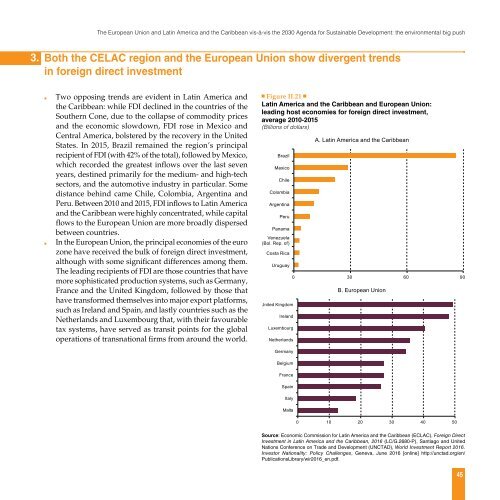La Unión Europea y América Latina y el Caribe ante la Agenda 2030 para el Desarrollo Sostenible: el gran impulso ambiental
Desde todas las regiones del planeta se observa con preocupación el aumento de la desigualdad global y la agudización de la crisis ambiental, especialmente en el caso del cambio climático. Frente a la complejidad de la situación, la comunidad internacional se ha movilizado a través de un extenso debate multilateral para ofrecer una respuesta amplia y ambiciosa. En los últimos meses se han puesto en marcha una serie de acciones colectivas que apuntan hacia un nuevo paradigma de desarrollo más sostenible e igualitario. En septiembre de 2015, la Asamblea General de las Naciones Unidas aprobó la Agenda 2030 para el Desarrollo Sostenible y los 17 Objetivos de Desarrollo Sostenible (ODS), con el reconocimiento de que el cambio climático y el desarrollo son inseparables. En esta línea, en diciembre de 2015 se aprobó el Acuerdo de París, en el que tanto naciones industrializadas como países en desarrollo se comprometen a gestionar la transición hacia una economía baja en carbono.
Desde todas las regiones del planeta se observa con preocupación el aumento de la desigualdad global y la agudización de la crisis ambiental, especialmente en el caso del cambio climático.
Frente a la complejidad de la situación, la comunidad internacional se ha movilizado a través de un extenso debate multilateral para ofrecer una respuesta amplia y ambiciosa. En los últimos meses se han puesto en marcha una serie de acciones colectivas que apuntan hacia un nuevo paradigma de desarrollo más sostenible e igualitario. En septiembre de 2015, la Asamblea General de las Naciones Unidas aprobó la Agenda 2030 para el Desarrollo Sostenible y los 17 Objetivos de Desarrollo Sostenible (ODS), con el reconocimiento de que el cambio climático y el desarrollo son inseparables. En esta línea, en diciembre de 2015 se aprobó el Acuerdo de París, en el que tanto naciones industrializadas como países en desarrollo se comprometen a gestionar la transición hacia una economía baja en carbono.
You also want an ePaper? Increase the reach of your titles
YUMPU automatically turns print PDFs into web optimized ePapers that Google loves.
The <strong>Europea</strong>n Union and <strong>La</strong>tin America and the Caribbean vis-à-vis the <strong>2030</strong> <strong>Agenda</strong> for Sustainable Dev<strong>el</strong>opment: the environmental big push<br />
3. Both the CELAC region and the <strong>Europea</strong>n Union show divergent trends<br />
in foreign direct investment<br />
■■<br />
■■<br />
Two opposing trends are evident in <strong>La</strong>tin America and<br />
the Caribbean: while FDI declined in the countries of the<br />
Southern Cone, due to the col<strong>la</strong>pse of commodity prices<br />
and the economic slowdown, FDI rose in Mexico and<br />
Central America, bolstered by the recovery in the United<br />
States. In 2015, Brazil remained the region’s principal<br />
recipient of FDI (with 42% of the total), followed by Mexico,<br />
which recorded the greatest inflows over the <strong>la</strong>st seven<br />
years, destined primarily for the medium- and high-tech<br />
sectors, and the automotive industry in particu<strong>la</strong>r. Some<br />
distance behind came Chile, Colombia, Argentina and<br />
Peru. Between 2010 and 2015, FDI inflows to <strong>La</strong>tin America<br />
and the Caribbean were highly concentrated, while capital<br />
flows to the <strong>Europea</strong>n Union are more broadly dispersed<br />
between countries.<br />
In the <strong>Europea</strong>n Union, the principal economies of the euro<br />
zone have received the bulk of foreign direct investment,<br />
although with some significant differences among them.<br />
The leading recipients of FDI are those countries that have<br />
more sophisticated production systems, such as Germany,<br />
France and the United Kingdom, followed by those that<br />
have transformed thems<strong>el</strong>ves into major export p<strong>la</strong>tforms,<br />
such as Ir<strong>el</strong>and and Spain, and <strong>la</strong>stly countries such as the<br />
Nether<strong>la</strong>nds and Luxembourg that, with their favourable<br />
tax systems, have served as transit points for the global<br />
operations of transnational firms from around the world.<br />
Figure II.21<br />
<strong>La</strong>tin America and the Caribbean and <strong>Europea</strong>n Union:<br />
leading host economies for foreign direct investment,<br />
average 2010-2015<br />
(Billions of dol<strong>la</strong>rs)<br />
Brazil<br />
Mexico<br />
Chile<br />
Colombia<br />
Argentina<br />
Peru<br />
Panama<br />
Venezu<strong>el</strong>a<br />
(Bol. Rep. of)<br />
Costa Rica<br />
Uruguay<br />
United Kingdom<br />
Ir<strong>el</strong>and<br />
Luxembourg<br />
Nether<strong>la</strong>nds<br />
Germany<br />
A. <strong>La</strong>tin America and the Caribbean<br />
0 30 60 90<br />
B. <strong>Europea</strong>n Union<br />
B<strong>el</strong>gium<br />
France<br />
Spain<br />
Italy<br />
Malta<br />
0 10 20 30 40 50<br />
Source: Economic Commission for <strong>La</strong>tin America and the Caribbean (ECLAC), Foreign Direct<br />
Investment in <strong>La</strong>tin America and the Caribbean, 2016 (LC/G.2680-P), Santiago and United<br />
Nations Conference on Trade and Dev<strong>el</strong>opment (UNCTAD), World Investment Report 2016.<br />
Investor Nationality: Policy Challenges, Geneva, June 2016 [online] http://unctad.org/en/<br />
PublicationsLibrary/wir2016_en.pdf.<br />
45


















